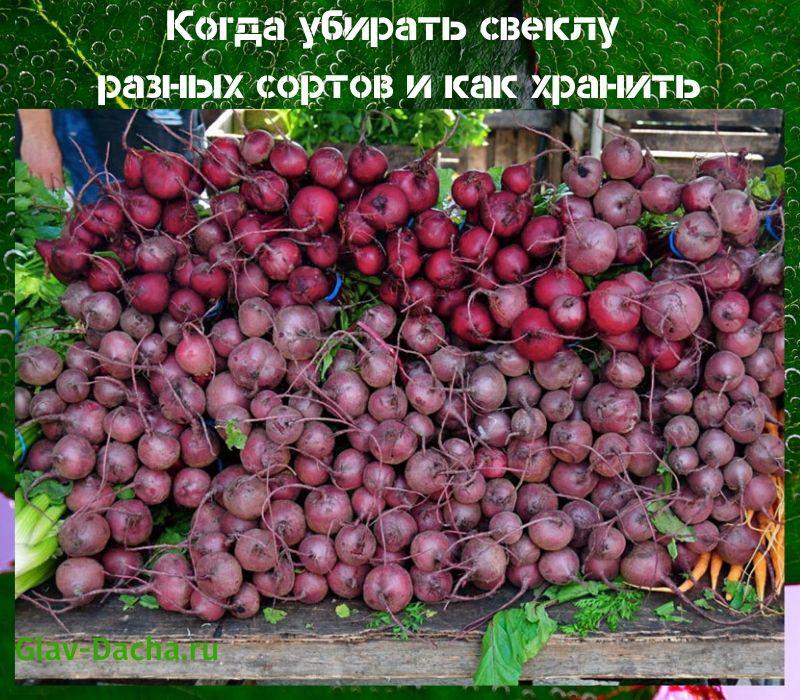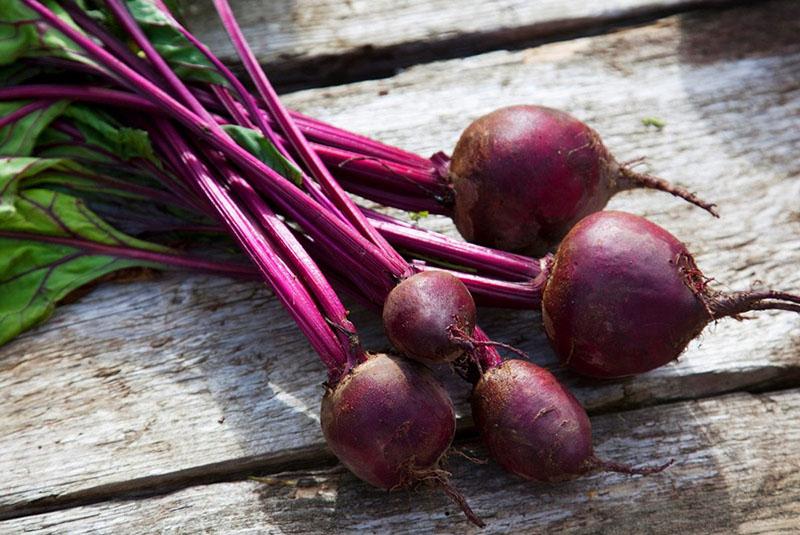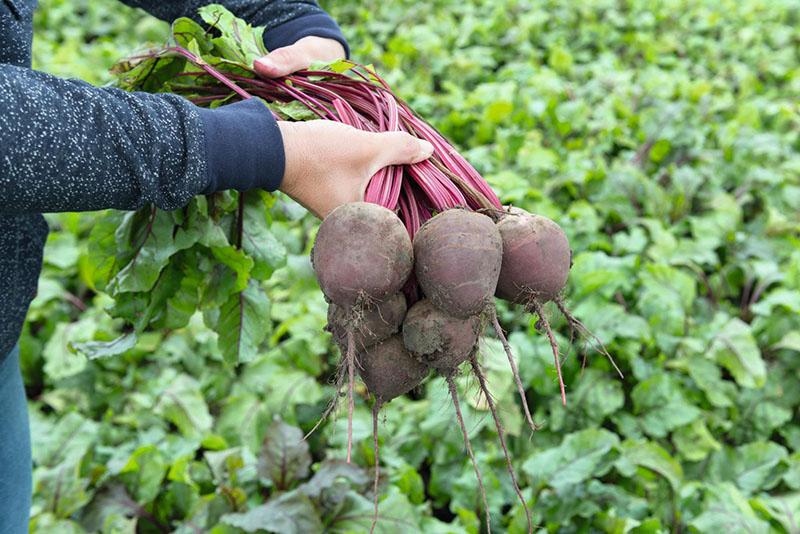When to harvest beets and how to store
 The taste and commercial qualities of beets depend not only on the variety, but also on when and how it was harvested from the garden, in what conditions this root crop was stored. Therefore, it is important to know when to harvest beets and how to preserve the crop without loss.
The taste and commercial qualities of beets depend not only on the variety, but also on when and how it was harvested from the garden, in what conditions this root crop was stored. Therefore, it is important to know when to harvest beets and how to preserve the crop without loss.
What determines the timing of harvesting beets

To determine the timing of harvesting beets, the following factors are important:
- Varietal features. Early, mid-ripening, late beets are planted at different times. The ripening period for each variety is individual, respectively, and the harvesting time is shifted.
- The climate of the region. When asked when to remove carrots and beets from the garden, residents of the Krasnodar Territory and Siberia will answer differently and will be right. When Siberians are already eating sauerkraut with beets, the Kuban people are just starting to harvest winter varieties.
- Weather. Experienced plant breeders are guided by the weather forecast and, taking this into account, adjust the harvest season. With prolonged rains, as well as a real threat of early autumn frosts, it is necessary to harvest root crops much earlier. Even if theoretically they can still grow up.
In order to use fresh produce from your own garden all year round, it is not enough to follow the cultivation techniques. It is important not to miss the moment of harvesting.
This amazing vegetable is suitable for use "tops and roots". Delicate beet tops perfectly replenish the reserves of vitamins and essential trace elements in the human body. Don't throw away foliage. It is used for the same purposes as the favorite spinach and celery.
When to harvest different varieties of beets
When buying seed, it should be borne in mind that not all varieties of beets are suitable for long-term storage.
Harvesting early varieties
 The "beetroot season" of early crops opens 50-90 days after the crop emerges. In most regions, this is mid to late June. Plantings withstand spring frosts and lack of moisture. In regions with a cold climate, they use the seedling method and cover the plantings with film.
The "beetroot season" of early crops opens 50-90 days after the crop emerges. In most regions, this is mid to late June. Plantings withstand spring frosts and lack of moisture. In regions with a cold climate, they use the seedling method and cover the plantings with film.
Root vegetables harvested from the garden in early summer are used for pickling, stewing, fresh for salads and snacks. Not recommended for long-term winter storage.
The most popular hybrids and varieties of early ripening beets among farmers and summer residents are Wodan, Podzimnyaya A-474, Krasny Shar.
Harvesting mid-season varieties
 Medium-ripening varieties are appreciated for their sweet, rich taste. Seeds are sown at the same time as early species, but ripening occurs 15-30 days later. This is due to the longer period of plant development - 100-110 days.
Medium-ripening varieties are appreciated for their sweet, rich taste. Seeds are sown at the same time as early species, but ripening occurs 15-30 days later. This is due to the longer period of plant development - 100-110 days.
Beets harvested in July and August are universal. It is suitable for fresh consumption, cooking and for winter preparations. If the conditions for storage are properly organized, then the root crop will retain its marketability for up to six months.
The division into early, mid-season and late varieties due to climate instability and different planting dates is very conditional. So, the popular variety Cylinder can be attributed to mid-season and late varieties.
Harvesting medium-late and late varieties
 Root crops that ripen in the fall are best suited for long winter storage.They are distinguished by resistance to temperature extremes, large size, dense pulp, elastic skin and color saturation - red or burgundy. The period of development to full maturity of a vegetable is from 90 to 140 days.
Root crops that ripen in the fall are best suited for long winter storage.They are distinguished by resistance to temperature extremes, large size, dense pulp, elastic skin and color saturation - red or burgundy. The period of development to full maturity of a vegetable is from 90 to 140 days.
The best "autumn" varieties of beets include Citadella, Mulatka, Renova, Odnorostkovaya, Matrona Sedek.
Harvesting dates are adjusted to reflect local weather conditions. One general rule applies: you need to have time to collect root crops from the beds before the first serious freeze.
Timing of harvesting beets for winter storage in different regions

When to dig up carrots and beets for storage, primarily depends on the weather and climatic characteristics of different regions of Russia:
- The difficult climatic conditions of Siberia and the Urals do not allow planting late-ripening varieties, they simply do not have time to ripen. Therefore, it is advisable here to choose early and mid-season varieties, with a ripening period of no more than a hundred days. A shortened period of warm days will allow the beets to fully ripen, gain juiciness, and accumulate a sufficient amount of nutrients. The harvesting season is at the end of August. In the case of a prolonged spring and late plantings, root crops are dug up in September.
- In central Russia and the Moscow region, the harvesting of beets intended for winter storage begins in the first month of autumn. If the ubiquitous hydrometeorological center does not promise a sharp cold snap, these works will be extended until mid-October.
- The easiest way to determine the timing is in the south of the country. Here late-ripening varieties, ready for harvesting in October, have time to ripen. If an unexpected cold snap is not expected, this period can be extended until mid-November. The warm climate in the Kuban and Stavropol regions makes it possible to grow two or three crops per summer season. Early and mid-early varieties are used for food during the summer. Late and late maturing are left for winter storage.
Attention should also be paid to the external signs of vegetable crops. The lower leaves of fully ripe beets are dry.
Most varieties by the time of full maturation have characteristic tubercles in the upper part of the root crop. Experienced gardeners use them to determine the degree of maturity.
Is it possible to harvest beets ahead of schedule
 Each stage in the development of a plant is important for obtaining certain characteristics. Only a fully ripe root crop has a sufficient degree of sugar content and fully reveals its potential in terms of flavor characteristics of the variety.
Each stage in the development of a plant is important for obtaining certain characteristics. Only a fully ripe root crop has a sufficient degree of sugar content and fully reveals its potential in terms of flavor characteristics of the variety.
A vegetable that has not passed all stages of development will dry out in storage. Even minor damage will accelerate the development of rot.
You should not overexpose the root crop in the garden. Overgrown beets become rough, bitter, not tasty, and will not be stored for a long time. If it rained for a long time, the earth is damp, it is advisable to wait until it dries up and only then start harvesting.
Unlike carrots, beets absolutely do not tolerate temperatures below zero. Therefore, it is necessary to harvest before the first frost.
Is there a difference in the timing of harvesting different types of beets
Of the thirteen species known in nature, included in the genus of beets, only two are considered cultivated plants: chard and common beets.
Harvesting Swiss chard
 Chard is a leafy and petioled beet that does not form a root crop, but a fibrous branched root. They eat "tops". The plant looks very decorative and is often grown in flower beds. For consumption, the above-ground part of the beet is cut off as it grows. The average ripening period is 1.5-2 months.
Chard is a leafy and petioled beet that does not form a root crop, but a fibrous branched root. They eat "tops". The plant looks very decorative and is often grown in flower beds. For consumption, the above-ground part of the beet is cut off as it grows. The average ripening period is 1.5-2 months.
Harvesting beetroot
 Beetroot is grown for delicious root crops. Subdivided into canteen, sugar and feed. There are two categories of beets used for food: red and white. Their taste is identical, but the second variant is less common due to the pale color.This is not surprising, since it is the rich red or burgundy color of beets that gives dishes a special aesthetics of taste.
Beetroot is grown for delicious root crops. Subdivided into canteen, sugar and feed. There are two categories of beets used for food: red and white. Their taste is identical, but the second variant is less common due to the pale color.This is not surprising, since it is the rich red or burgundy color of beets that gives dishes a special aesthetics of taste.
Varietal characteristics and climatic conditions play an equally important role in determining when to harvest any type of beet.
 Sugar beets are industrial crops, they are planted to produce sugar and ethyl alcohol. Harvesting of this crop in the fields in different regions of the country is carried out from August to October.
Sugar beets are industrial crops, they are planted to produce sugar and ethyl alcohol. Harvesting of this crop in the fields in different regions of the country is carried out from August to October.
 Fodder beets are also classified as technical. It was bred by breeders specifically for feeding animals. It contains much more protein and coarse fiber than table varieties. Larger in size than the dining room. Buried in the ground by about a third. This growth feature facilitates the process of mechanized harvesting, which falls in September and early October.
Fodder beets are also classified as technical. It was bred by breeders specifically for feeding animals. It contains much more protein and coarse fiber than table varieties. Larger in size than the dining room. Buried in the ground by about a third. This growth feature facilitates the process of mechanized harvesting, which falls in September and early October.
Harvesting beets according to the lunar calendar
 The gardener's lunar calendar marks not only the days favorable for planting and carrying out various agrotechnical measures in relation to various crop crops.
The gardener's lunar calendar marks not only the days favorable for planting and carrying out various agrotechnical measures in relation to various crop crops.
For vegetables that are laid for long-term storage, harvesting dates are also scheduled. There are times when you can remove beets from the garden with maximum efficiency. It is believed that this should be done on a full or waning moon.
In 2020, astrologers are advised to remove the grown beets for winter storage on the following days:
- August 3-19;
- September 2-17;
- 2-16, October 31;
- 1-15, 30 November
- December 1-14.
At this time, all metabolic processes in plants slow down, so the preservation of vegetables will be of better quality. The Moon in Libra, Capricorn and Sagittarius is considered the most favorable for harvesting root crops.
How to properly remove beets from the garden and lay them for winter storage
 The safety of the crop is in direct proportion to the careful attitude to the root crop during the harvesting process. On small plantations, it is advisable to do this manually. The beets are removed from the ground by holding the base of the tops. If the soil is clayey, hard, you can use a shovel or pitchfork, turning the clod over.
The safety of the crop is in direct proportion to the careful attitude to the root crop during the harvesting process. On small plantations, it is advisable to do this manually. The beets are removed from the ground by holding the base of the tops. If the soil is clayey, hard, you can use a shovel or pitchfork, turning the clod over.
After the garden is empty, you need to prepare the vegetables for winter storage:
- cut off the tops with a knife or scissors, leaving a stump of 1-2 cm;
- spread out in one layer in a dry, shaded, well-ventilated place (preferably under a canopy);
- perform sorting, discarding damaged instances;
- carefully put the selected root crops in the boxes, sprinkling with peat, wood ash or dry sand;
- put in a cool dry cellar.
 The optimal storage temperature is 0 ... -2 ℃, the humidity level is 80-90%. When placing root vegetables in a box, you need to make sure that they do not come into contact with each other.
The optimal storage temperature is 0 ... -2 ℃, the humidity level is 80-90%. When placing root vegetables in a box, you need to make sure that they do not come into contact with each other.
Beets must not be washed before being sent to the cellar. An adhered earthen lump cannot be forcibly scraped off, as there is a risk of damaging the peel.
Vegetables are washed of soil and sand just before using it for cooking.
How to preserve the harvest if there is no cellar
 There are several ways to keep root crops fresh and juicy until spring in urban or summer cottages.
There are several ways to keep root crops fresh and juicy until spring in urban or summer cottages.
One of them:
- Place dried root vegetables with cut tops in rows in a cardboard or wooden box or plastic container, sprinkling with sand, sawdust, shavings.
- Put the box with vegetables in a larger cardboard box and fill the voids with any insulation.
- Put it on an unheated balcony or loggia.
Such a multilayer chest will keep a healthy vegetable fresh for 4-6 months.
If the apartment does not have a balcony, you can store the beets at room temperature for two months in the following way:
- dip each root vegetable in a clay mash;
- dry at room temperature;
- put in a cardboard box or bucket;
- put away from a heat source (gas stove, heating radiators).
In the country or on a personal plot, part of the crop can be kept fresh until spring in the ground:
- dig a hole 80-100 cm deep;
- put the beets in a bucket or large saucepan, sprinkling each layer with sand;
- close the container with a lid;
- lower stocks into a pit;
- close the top with cardboard, any layer of insulation;
- cover the pit with a sheet of slate, an iron sheet;
- sketch on top of a layer of earth 5-10 cm.
The degree of insulation of such mini-cellars depends on how much the soil freezes in the region. The place is chosen so that in winter this area will be covered with snow.
Beets are widely used for winter harvesting. Root vegetables, packed in a vapor-permeable cling film, are successfully stored in the refrigerator for several weeks.
Interesting facts about beets

Despite the fact that the first root forms of beets were well known to mankind in the 4th century BC. e., culture spread to all continents only from the late 19th and early 20th centuries.
The Bordeaux 237 variety, known to everyone from childhood, which is ideal for growing in difficult climatic conditions in Russia, has been for over 100 years.
Currently, more than 70 hybrids and varieties of beets have been zoned. They are distinguished by their productivity, early maturity, appearance, taste and the ability to retain color brightness during culinary processing.
If the time for caring for the beds on six acres is limited, you should pay attention to the One-sprout variety, which does not require thinning. Breeders have bred yellow and striped types of beets. Their advantage lies in decorativeness.
When boiling beets, you do not need to add salt to the water, this will increase the cooking time of the vegetable, which is already cooked for a long time due to the large amount of fiber.
Beetroot is a unique crop that requires a minimum of effort to grow and care, but allows you to get a rich harvest even from a small plot. Compliance with the terms and rules of harvesting will delight the family with fresh healthy vegetables all winter.
Surprisingly, when harvesting beets is enjoyable, they last longer and taste better. Maybe it's because a crop grown with love always brings more joy.